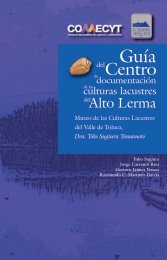You also want an ePaper? Increase the reach of your titles
YUMPU automatically turns print PDFs into web optimized ePapers that Google loves.
KORPUS <strong>21</strong>, VOL. 2, NÚM. 4, 2022, 117-132<br />
Legislative frameworks<br />
Women had a limited set of legislative and<br />
institutional spaces to which they could recur<br />
in the case of sexual harassment. With<br />
no specific mention of sexual harassment<br />
in Mexican labor codes prior to 1970, a woman’s<br />
complaint rose to the level of a civil<br />
case if she chose to seek redress. The Mexican<br />
Penal Code of 1872, a virtual copy of<br />
the Spanish Penal Code of 1870, “down to<br />
the grammatical errors”, according to one<br />
jurist, accounted for, described, and provided<br />
remedy for atentado al pudor (acts<br />
against modesty) (Almaráz, 1931:11-16). Title<br />
Six, Chapter III, article 789 of the Code stated<br />
that atentado al pudor included “any<br />
immodest act that could offend and that is<br />
enacted against the will of another person,<br />
regardless of their sex, but that does not<br />
result in copulation” (Ministerio de Justicia<br />
e Instrucción Pública, 1872: 289). The stipulated<br />
punishment for atentado al pudor<br />
differed according to whether the act was<br />
committed with physical or moral violence.<br />
Whereas some jurists argued for a narrow<br />
definition of the crime, others considered a<br />
wide range of behaviors to fall within the<br />
legal definition of atentado al pudor. Licenciado<br />
Salvador J. Ferrer published a study<br />
in 1904 in the Diario de Jurisprudencia <strong>del</strong><br />
Distrito y Territorios that argued atentado<br />
al pudor should be understood to exist in<br />
degrees of intention and offense. The possibility<br />
of offense was contingent on social<br />
c<strong>las</strong>s and respectability. Ferrer wrote that<br />
the offence included:<br />
Any immodest act, from a simple gesture<br />
to certain types of touch; and this range of<br />
acts should be evaluated according to their<br />
seriousness and the social condition of the<br />
individual in question in order to determine<br />
the nature of the crime and the level of punishment.<br />
To be sure, violations of modesty by<br />
means of dishonest gestures is not as serious<br />
a crime as that of more or less vulgar caresses<br />
or more or less indecent touching. Nor<br />
are these of equal seriousness when inflicted<br />
upon a person known as honest as when they<br />
are inflicted upon a person of licentious habits;<br />
and it is inconceivable that such an offense<br />
could be considered against a public woman<br />
or a person, due to age or social condition,<br />
who has no concept of modesty (Ferrer, 1904:<br />
638-639).<br />
By including indecent gestures and touching,<br />
Ferrer opened room for a wide range<br />
of behaviors to be included in the legal<br />
definition of atentado al pudor. At the same<br />
time, the ambiguous characterizations of<br />
those gestures and touch as “more or less<br />
indecent or offensive,” meant that context<br />
was essential to interpreting the law. In<br />
particular, the respectability of the woman<br />
in question determined whether such acts<br />
could be considered criminal. A woman’s<br />
reputation and occupation were both relevant.<br />
While factory workers and office employees<br />
were by no means considered “public<br />
women” (prostitutes), women’s recent<br />
entrance into new public spaces blurred the<br />
boundaries of their respectability –recall the<br />
comments of Federico Gamboa and journalists<br />
regarding the “mixing of the sexes” and<br />
the “sarcasm” that characterized the workplace<br />
into which those women had chosen<br />
to enter. The organization of the workplace<br />
meant that a woman who was held back<br />
to take dictation in her bosses’ office after<br />
hours, for example, might have been clear<br />
that her boss had crossed a line, but not<br />
confident that she could defend her own<br />
reputation in a court of law or of public opinion.<br />
Further increasing the stakes, article<br />
86 of the Código de Procedimientos Penales<br />
<strong>del</strong> Distrito Federal y Territorios stated<br />
that an investigation into accusations of<br />
atentado al pudor could include a medical<br />
examination, something many women may<br />
have considered revictimization (El Asesor<br />
Jurídico, 1908: 90).<br />
Between the Penal Code of 1872 and that<br />
of 1931, only minor changes were made to<br />
articles related to atentado al pudor. A study<br />
to revise the 1872 Penal Code was conducted<br />
in 1913, but was later dismissed when, in<br />
late 1925, the President charged a committee<br />
to revise the Penal Code. The committee<br />
123



![bicentenario_1[V2]](https://img.yumpu.com/68677971/1/167x260/bicentenario-1v2.jpg?quality=85)
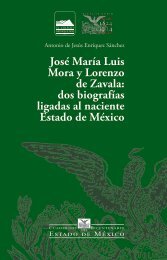
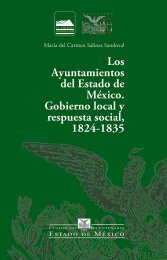

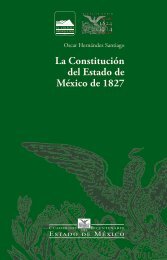
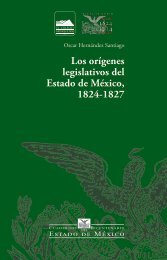
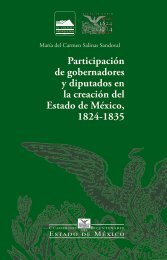
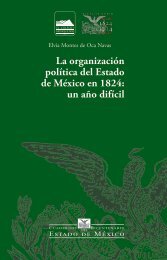
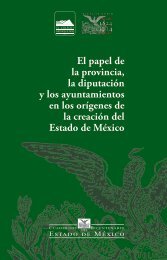

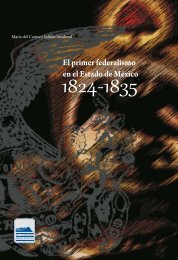
![El_primer_federalismoEM[final]_compressed (2)](https://img.yumpu.com/68483279/1/178x260/el-primer-federalismoemfinal-compressed-2.jpg?quality=85)

